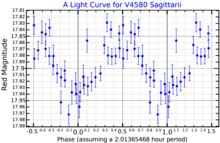| This article needs additional citations for verification. Please help improve this article by adding citations to reliable sources. Unsourced material may be challenged and removed. Find sources: "SAX J1808.4−3658" – news · newspapers · books · scholar · JSTOR (January 2017) (Learn how and when to remove this message) |
| Observation data Epoch J2000.0 Equinox J2000.0 (ICRS) | |
|---|---|
| Constellation | Sagittarius |
| Right ascension | 18 08 27.54 |
| Declination | −36° 58′ 44.3″ |
| Apparent magnitude (V) | 16.51 |
| Spectral type | Neutron star |
| Other designations | |
| V4580 Sgr, PSR J1808−3658, SWIFT J1808.5−3655, INTREF 881, XTE J1808−369 | |
| Database references | |
| SIMBAD | data |
The first accreting millisecond pulsar discovered in 1998 by the Italian-Dutch BeppoSAX satellite, SAX J1808.4−3658 revealed X-ray pulsations at the 401 Hz neutron star spin frequency when it was observed during a subsequent outburst in 1998 by NASA's RXTE satellite. The neutron star is orbited by a brown dwarf binary companion with a likely mass of 0.05 solar masses, every 2.01 hours. X-ray burst oscillations and quasi-periodic oscillations in addition to coherent X-ray pulsations have been seen from SAX J1808.4-3658, making it a Rosetta stone for interpretation of the timing behavior of low-mass X-ray binaries.

These accreting millisecond X-ray pulsars are thought to be the evolutionary progenitors of recycled radio millisecond pulsars. A total of thirteen accreting millisecond X-ray pulsars have been discovered as of January 2011. Three of them are Intermittent millisecond X-ray pulsars (HETE J1900.1-2455, Aql X-1 and SAX J1748.9-2021), i.e. they emit pulsations sporadically during the outburst.
On 21 August 2019 (UTC; 20 August in the US), Neutron Star Interior Composition Explorer (NICER) spotted the brightest X-ray burst so far observed. It came from SAX J1808.4−3658.
References
- ^ "SAX J1808.4-3658". SIMBAD. Centre de données astronomiques de Strasbourg. Retrieved 15 January 2017.
- Wijnands, Rudy; van der Klis, Michiel (1998). "A millisecond pulsar in an X-ray binary system". Nature. 394 (6691): 344–346. Bibcode:1998Natur.394..344W. doi:10.1038/28557. S2CID 4428048.
- Elebert, P.; Reynolds, M. T.; Callanan, P. J.; Hurley, D. J.; Ramsay, G.; Lewis, F.; Russell, D. M.; Nord, B.; Kane, S. R.; Depoy, D. L.; Hakala, P. (May 2009). "Optical spectroscopy and photometry of SAX J1808.4-3658 in outburst". Monthly Notices of the Royal Astronomical Society. 395 (884–894). arXiv:0901.3991. Bibcode:2009MNRAS.395..884E. doi:10.1111/j.1365-2966.2009.14562.x.
- NICER Telescope Spots Brightest X-Ray Burst Ever Observed
This variable star–related article is a stub. You can help Misplaced Pages by expanding it. |